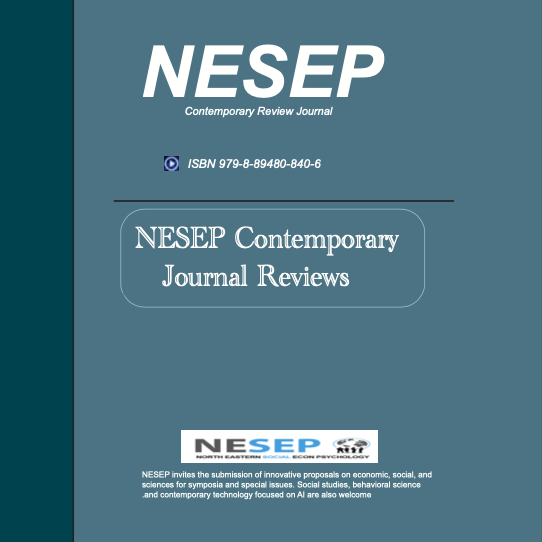Accepted Articles
We congratulate you on acceptance of your manuscript.

Annual Expo by the Journal of Young Explorers Meta and NESEP
- Fundamental or applied research
- Interdisciplinary research
- Judging on a rolling basis
- A work-in-progress research
- Completed research
- Unlimited topics and ideas
- ISBN 979-8-89480-840-6
- NESEP/NY-CSEF event at Harvard Club in NYC
Syncretic Progression of Korean Shamanism for Spiritual Guidance in Contemporary Society
Abstract: Korean shamanism is a traditional spiritual practice in Korea that has its roots in ancient shamanistic rituals originating in Siberia that has been altered over time to align with Korea’s cultural beliefs and values. Shamanism had played a vital role in Korean society throughout its history but faced growing criticism during the Joseon period when it conflicted with Confucianist and Christian tenets. Moreover, shamanism was viewed as "unmodern" and irrational throughout the Japanese colonial period and even during the early decades of Korea's independence. Notwithstanding the public display of certain government-sanctioned rituals in an effort to uphold the country's cultural heritage, many shamans in today’s society have resorted to conducting more private rituals oftentimes conducted in secrecy. Nevertheless, Korean shamanism has endured and arguably has experienced a resurgence in recent years, even in the midst of the country's widespread urbanization and global diaspora of Koreans.
This paper attempts to consider some historical and contemporary issues around Korean shamanism, including the role of mudangs in preserving Korea's cultural heritage as well as guiding and healing individuals spiritually. Additionally, concerns about the commercialization of shamanic practices and the appropriation of shamanic symbols and rituals in contemporary popular culture are analyzed. Overall, Korean shamanism has been effective in adapting syncretically to remain an important part of Korea's cultural heritage and identity, and its practitioners and supporters continue to advocate for its recognition and preservation within Korea and beyond through the Korean diaspora for both emotional support and spiritual guidance.
Keywords: Shamanism, syncretism, mudang, spiritual practices, neo-shamanism, kut, divination
References
-
Baker, D. L. (2010). Shamans in Today’s Korea. Education About Asia. Volume 15:1.
-
Brooksbank, T. (2018, April 25). My Experience With a Korean Fortune Teller. Annenberg Media. Retrieved March 17, 2023, from https://www.uscannenbergmedia.com/2018/04/25/my-experience-with-a-korean-fortune-teller/.
-
Choe, S.-H. (2007, July 6). In the age of the Internet, Korean shamans regain popularity. New York Times. Retrieved March 1, 2023, from https://www.nytimes.com/2007/07/06/world/asia/06iht-shaman.1.6527738.html.
-
Chung, S. (2022, November 23). The seed of Korean Christianity grew in the soil of shamanism. ChristianityToday.com. Retrieved March 1, 2023, from https://www.christianitytoday.com/ct/2022/november-web-only/korea-shamanism-christianity-pyongyang-revival.html.
-
Hong, K. S. (2015). Korean Shamanism: From Tradition To Change In the U.S. Diasporic Context. Ph.D. Dissertation for Drew Theological School (Drew University, NJ).
-
Hwang, M. (2007). The Mudang: The Colonial Legacies of Korean Shamanism. In Han Kut: Critical Art and Writing by Korean Canadian Women, edited by The Korean Canadian Women's Anthology Collective. Pp 103-119.
-
Jones, D. R. (2021, February 25). Spirit Possession and Shamanic Ritual in South Korea: Business is booming. Folklore Thursday.com. Retrieved 3/1/2023, from https://folklorethursday.com/folklife/spirit-possession-and-shamanic-ritual-in-south-korea-business-is-booming/.
-
Kendall, L. (2010). Old Gods, New Times: A Shaman Ritual in South Korea. Education About Asia. Volume 15:1.
-
Phillips, J. (2014). Retrieving the Lost Souls of Modernity: A Study of Neo-Shamanic Practice. (thesis). Whitman College, Walla Walla, WA.
-
Raz. (2020, March 27). On neo-shamanism. Medium. Retrieved March 14, 2023, from https://medium.com/theological-and-religious-archetypes/neoshamanism-28a ec913ba2.
-
Silcott, W. (2009). Invention and Reinvention in Modern South Korean. Published in Fairmount Folio: Journal of History.
-
Walraven, B. (1993). Our shamanistic past: The Korean government, shamans and shamanism. The Copenhagen Journal of Asian Studies, 8. https://doi.org/10.22439/cjas.v8i1.1819
-
Walraven, B. (2009). National pantheon, regional deities, personal spirits? Mushindo, songsu, and the nature of Korean shamanism. Asian Ethnology, 68(1): 55–80.